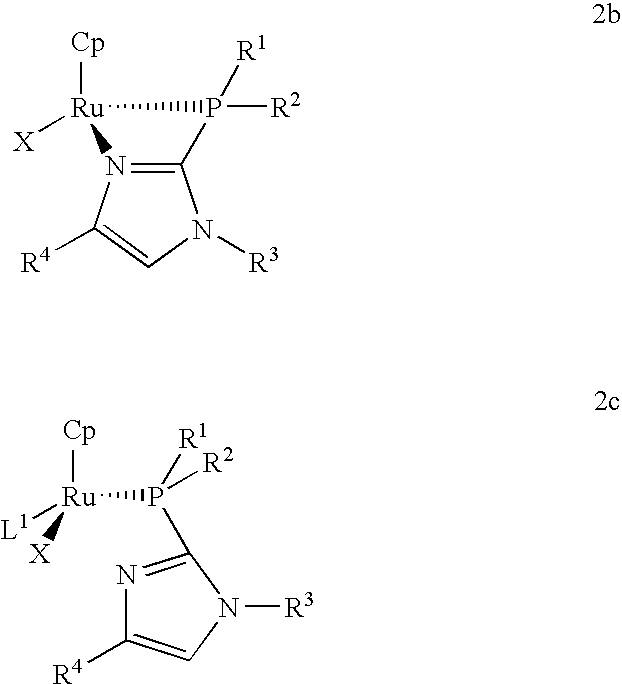Catalysts for alkene isomerization and conjugating double bonds in polyunsaturated fats and oils
a technology of polyunsaturated fats and alkene, which is applied in the field of catalysts for alkene isomerization and conjugation double bonds in polyunsaturated fats and oils, can solve the problems of limiting the use of methylene interruption in industrial applications
- Summary
- Abstract
- Description
- Claims
- Application Information
AI Technical Summary
Benefits of technology
Problems solved by technology
Method used
Image
Examples
experiment 1
Isomerization of 4-allylanisole by —P(i-Pr)2 Exemplary Catalyst of this Invention 13a
[0119]
4-allylanisole (E)-4-(prop-1-en-1-yl)anisole
[0120]For 4-allylanisole: 1H NMR (600 MHz, acetone-d6) δ 7.11 (˜d, J≈8 Hz, 2H), 6.85 (˜d, J≈8 Hz, 2H), 5.94 (tdd, J=6.7, 10.1, 17.0, 1H), 5.04 (˜q of d, J≈2, =17.0, 1H), 4.99 (tdd, J=1.3, 2.2, 10.1, 1H), 3.76 (s, 3H), 3.31 (d, J=6.4 Hz, 2H).
[0121]For 4-(E-prop-1-en-1-yl)anisole: 1H NMR (400 MHz, acetone-d6) δ 7.28 (˜d, J≈9 Hz, 2H), 6.85 (˜d, J≈9 Hz, 2H), 6.36 (qd, J=1.8, 15.7 Hz, 1H), 6.11 (qd, J=6.6, 15.7, 1H), 3.78 (s, 3H), 1.82 (dd, J=1.8, 6.6, 3H).
TABLE 1Primary data (measured integrals in arbitrary units) and derivedper cent starting material remaining and product yields.Chemical shiftsTimeCompound(s)aof resonances (ppm)0 h1 h100 hsm + p3.76-3.80 (3H; all —OCH3167.83156.62167.98peaks)units per proton for55.9452.2155.99—OCH3 peak(s)sm7.11110.8400sm6.85112.15eesm5.9455.5300sm5.04 + 4.99111.3500sm3.31110.7000smunits per protonb55.6100sm% starting m...
experiment 2
Isomerization of 4-allylanisole by —PPh2 Exemplary Catalyst of this Invention 13b
[0122]
TABLE 2Primary data (measured integrals in arbitrary units) and derivedpercent starting material remaining and product yields.Com-Chemical shiftsTimepound(s) aof resonances0 h1 h2 h100 hsm + p3.76-3.80 (3H;340.58338.82342.24373.02all —OCH3 peaks)units per proton113.53112.94114.08124.34for —OCH3 peak(s)sm7.11224.839.9200sm6.85227.82eeesm5.94110.066.3900sm5.04 + 4.99226.4111.0200sm3.31225.74ff0smunits per proton b112.765.4700sm% starting material1004.800remaining cp7.280214.82220.37246.02p6.360108.19114.26122.23p6.110107.82115.09122.40p1.820318.85325.58366.36punits per proton b0107.1110.76122.43p% yield of product d094.897.198.5a “Sm” and “p” mean starting material and product, respectively.b Calculated by taking the average of integrations of the specified resonances.c Calculated by dividing units per proton of starting material at time indicated by units per proton value for —OCH3 peak(s).d Calcul...
experiment 3
Isomerization of Diallyl Ether by —P(i-Pr)2 Exemplary Catalyst of this Invention 13a
[0123]
[0124]For intermediate: 1H NMR (600 MHz, acetone-d6) δ 6.23 (qd, J=1.7, 12.5), 5.91 (tdd, J=5.3, 10.5, 17.2, 1H), 5.27 (˜q of d, J≈1.7, 17.2, 1H), 5.14 (˜q of d, J≈1.6, 10.5, 1H), 4.76 (qd, J=6.7, 12.3, 1H), 4.16 (td, J=1.5, 5.2, 2H), 1.51 (dd, J=1.6, 6.7, 3H).
[0125]For product: 1H NMR (600 MHz, acetone-d6) δ 6.29 (qd, J=1.7, 12.3), 4.99 (qd, J=6.8, 12.1, 2H), 1.54 (dd, J=1.7, 7.0, 6H).
TABLE 3Primary data (measured integrals in arbitrary units) and derivedpercent starting material remaining and product yields.Com-Chemical shiftsTimepound(s) aof resonances0 h1 h8 h27 hsm5.90 (2H)109.61eeesm5.25 (2H)108.73eeesm5.12 (2H)113.176.1800sm3.95 (4H)223.3610.7000smunits per proton b55.492.8100sm% starting material1005.100remaining ci6.23 (1H)036.189.551.92i5.14 (1H)036.018.971.87i4.76 (1H)036.029.011.65i4.16 (2H)072.7517.182.98i1.51 (3H)0108.0927.21 10.54 fiunits per proton b036.138.991.68i% yield of065...
PUM
 Login to View More
Login to View More Abstract
Description
Claims
Application Information
 Login to View More
Login to View More - R&D
- Intellectual Property
- Life Sciences
- Materials
- Tech Scout
- Unparalleled Data Quality
- Higher Quality Content
- 60% Fewer Hallucinations
Browse by: Latest US Patents, China's latest patents, Technical Efficacy Thesaurus, Application Domain, Technology Topic, Popular Technical Reports.
© 2025 PatSnap. All rights reserved.Legal|Privacy policy|Modern Slavery Act Transparency Statement|Sitemap|About US| Contact US: help@patsnap.com



